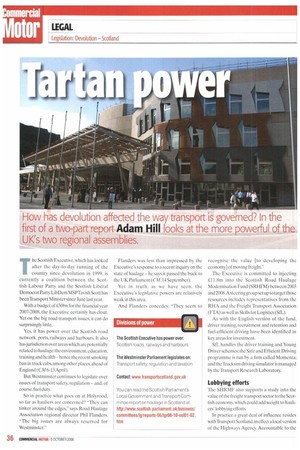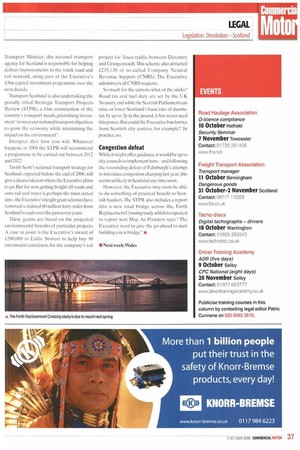How has devolution affected the way transport is governed? In
Page 36

Page 37

If you've noticed an error in this article please click here to report it so we can fix it.
the first of a two-part report Adam Hill looks at the more powerful of the UK's two regional assemblies.
The Scottish Executive, which has looked after the day-to-day running of the country since devolution in 1999, is currently a coalition between the Scottish Labour Party and the Scottish Liberal Democrat Party. LibDem MSPTavish Scott has been Transport Minister since June last year.
With a budget of 130bn for the financial year 2007-2008, the Executive certainly has clout. Yet on the big road transport issues, it can do surprisingly little.
Yes, it has power over the Scottish road network, ports, railways and harbours. It also hasjurisdiction over areas which arc potentially related to haulage: the environment,education, training and health hence the recent smoking ban in truck cabs, among other places. ahead of England (CM 6-13 April).
But Westminster continues to legislate over issues of transport safety, regulation and, of course, fuel duty.
So in practice what goes on at Holyrood, so far as hauliers are concerned? -They can tinker around the edges," says Road Haulage Association regional director Phil Flanders. "The big issues are always reserved for Westminster." Flanders was less than impressed by the Executive's response to a recent inquiry on the state of haulage he says it passed the buck to the UK Parliament (C/14,14 September).
Yet in truth, as we have seen, the Executive's legislative powers are relatively weak in this area.
And Flanders concedes: -They seem to recognise the value [to developing the economy] of moving freight."
The Executive is committed to injecting £11.8m into the Scottish Road Haulage Modernisation Fund (SRHFM) between 2003 and 2008.A steering group set up to target those resources includes representatives from the RHA and the Freight Transport Association (ETA) as well as Skills for Logistics (SfL).
As with the English version of the fund, driver training, recruitment and retention and fuel-efficient driving have been identified as key areas for investment.
SfL handles the driver training and Young Driver schemes; the Safe and Efficient Driving programme is run by a firm called Momenta; and the Trucksim driving simulator is managed by the Transport Research Laboratory.
Lobbying efforts
The SHRMF also supports a study into the value of the freight transport sector to the Scottish economy which could add weight to hauliers' lobbying efforts In practice a great deal of influence resides with Transport Scotland, in effect a local version of the Highways Agency. Accountable to the Transport Minister, this national transport agency for Scotland is responsible for helping deliver improvements to the trunk road and rail network, using part of the Executive's i3bn capital investment programme over the next decade.
Transport Scotland is also undertaking the grandly titled Strategic Transport Projects Review (STPR), a .E4m examination of the country's transport needs, prioritising investment "to meet our national transport objectives to grow the economy while minimising the impact on the environment".
Interpret that how you will. Whatever happens, in 2008 the STPR will recommend a programme to be carried out between 2012 and 2022.
Tavish Scott's national transport strategy for Scotland, expected before the end of 2006, will give a clearer idea on where the Executive plans to go. But for now, getting freight off roads and onto rail and water is perhaps the main stated aim—the Executive's freight grant schemes have removed a claimed 60 million lorry miles from Scotland's roads over the past seven years.
These grants are based on the projected environmental benefits of particular projects. A case in point is the Executive's award of £200,000 to Eddie Stobart to help buy 90 intermodal containers for the company's rail project for Tesco traffic between Daventry and Grangemouth.This scheme also attracted 1235,130 of so-called Company Neutral Revenue Support (CNRS). The Executive administers all CNRS requests.
So much for the carrots; what of the sticks? Road tax and fuel duty are set by the UK Treasury, and while the Scottish Parliament can raise or lower Scotland's basic rate of income tax by up to 3p in the pound, it has never used this power. But could the Executive ban lorries from Scottish city centres, for example? In practice, no.
Congestion defeat
While it might offer gui.dance, it would he up to city councils to implement bans—and following the resounding defeat of Edinburgh's attempt to introduce congestion charging last year, this seems unlikely in Scotland any time soon.
However. the Executive may soon be able to do something of practical benefit to Scottish hauliers.The STPR also includes a report into a new road bridge across the, Forth Replacement Crossing study, which is expected to report next May. As Flanders says: "The Executive need to give the go-ahead to start building a new bridge." •
























































































































































































